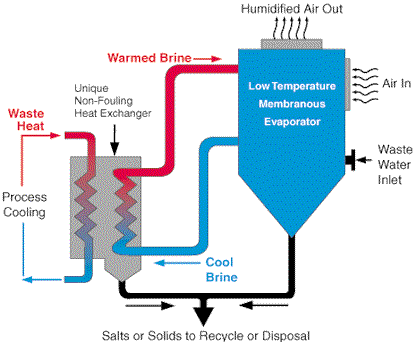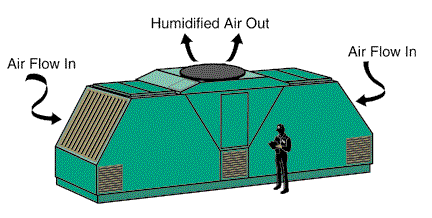| Reduce or Eliminate
Wastewater Disposal Costs!
Energetech Offers SynThermic Waste Heat Evaporators
Eliminate your wastewater disposal problems while providing
efficient process cooling. These SynThermic units use low-temperature waste heat to dispose of wastewater in
an innovative evaporation process.
Save Money and Get Free Cooling
• Reduce or eliminate water disposal costs.
• Provide additional or complete cooling for process, compression,
power generation, refrigeration systems and many other applications.
Synthermic Evaporative Benefits
The SynThermic system utilizes an innovative low-temperature process
providing a number of advantages:
• The process uses low temperature, otherwise unusable,
waste heat.
• Low operating temperatures permit the use of non-corrosive
plastics.
• No scaling and fouling with high TDS fluids.
• Operates efficiently at varying loads.
• Excellent process for concentration and precipitation of
dissolved materials.
• Portable or permanent installations.
• Equipment is reliable and easily maintained in the field.
• Can be fully automated for efficient operations at
unmanned or remote
locations.
• Fresh-water recovery option available.
Dissolved or Suspended Solids -- No Problem!
The Synthermic process is not affected by the
quality or composition of the dissolved solids in the wastewaters.
Fluids up to 320,000 ppm dissolved solids, as well as fluids with high levels of
suspended solids have been processed successfully.
Heat Sources
The Synthermic units can use low-grade heat
such as heat generated by:
• Compressor stations
• Refinery heat-exchange systems
• Gas lift operations
• Boilers or burner flue gas
• Wellhead compressors
• Genset operations
• Refrigeration systems
• Units also may be fired directly with oil, gas or methane.
Examples of Savings
• Waste brine application at 3,000 bpd for gas field
operations saved more than $1200 per day in
disposal and transportation costs.
• Dilute glycol concentration using waste heat saves nearly
$96,500 per year in fuel and boiler conditioning
costs.
• Food processing plant eliminates liabilities and $100,000
in expenses associated with large evaporative pond for disposal
of saline process waters.


|
How it Works
Waste heat is transferred through a proprietary non-fouling heat
exchanger into a concentrated wastewater (cool brine).
The warmed brine enters the evaporation chamber.
Airflow into evaporation chamber drops the vapor pressure and the vaporization
temperature of the warmed brine. Wastewater is partially vaporized.
As wastewater vaporizes, salts and other solids collect on membrane surfaces in the
evaporator.
Vibration causes solids to regularly peel into a collection system for removal. The
cool brine remaining after vaporization is reheated in the heat exchanger and the process
repeats. |